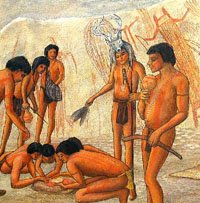
Participants in a ritual anoint themselves
with red paint. The scene is a rockshelter in the Lower
Pecos as envisioned by artist and archeologist Reeda Peel. |
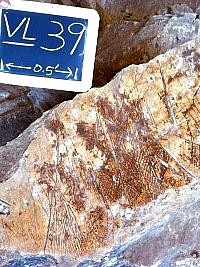
Petroglyphs of various styles also
occur in the Lower Pecos. This example has incised lines
cut by sharp flint tools. Photo from ANRA-NPS Archives at TARL. |
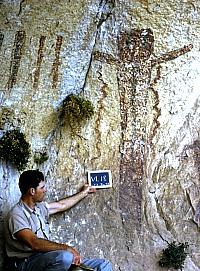
This rock art panel has several styles
of Lower Pecos rock art. Most of the elements including
the large shaman figure just to the right of the sign
board are of the Pecos River style. But the smaller
dark red anthropomorphic figure with down-turned arms
just to the right of the shaman element is of the Red
Monochrome style. Photo from ANRA-NPS Archives at TARL. |
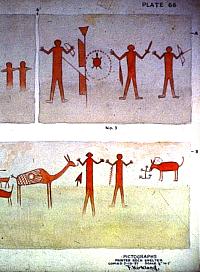
Example of one of Forest Kirkland's
original watercolors of pictograph panels at Painted
Rock Shelter in Painted Canyon, a small side canyon
of the Rio Grande near Comstock, Texas. Most of these
figures are of the Red Monochrome style. Kirkland made
these "copies" as he called them, on July
13, 1937. As subsequent recorders have learned, copying
rock art is a subjective process—what is copied
depends on lighting conditions, condition of the pictographs,
and the eye and skill of the beholder. Photo from ANRA-NPS
Archives at TARL. |
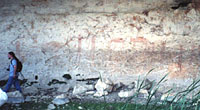
Today the Red Monochrome pictographs
at Painted Rock Shelter persist despite periodic inundation
and fluctuating moisture levels. Photo by Steve Black. |
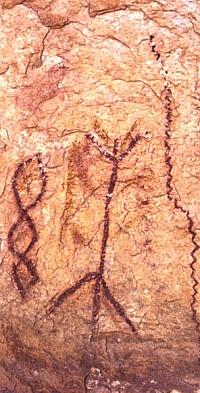
Close up of Red Linear pictographs.
Photo by Steve Black. |
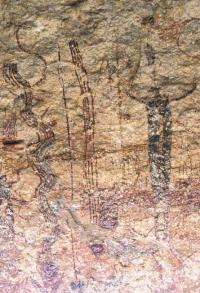
Pecos River style pictographs in
Rattlesnake Canyon. One of the serpentine "rattlesnakes"
can be seen to the left of the dark shaman figure. Photo
by Steve Black. |
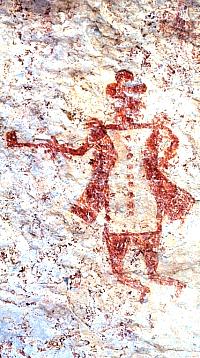
Close up of pictograph of European
man, probably a Spaniard, at Vaquero Alcove. This was
obviously painted by an Indian who had personally witnessed
the man. This style shares strong similarities with
the Plains Bibliographic style. Photo from ANRA-NPS
Archives at TARL.
|
|
The painted images adorning the walls of hundreds
of rockshelters and minor overhangs uniquely define the Lower
Pecos archeological region. The striking and inspiring rock
art is celebrated, photographed, illustrated,
recorded, and studied by hundreds of enthusiasts across the
country and a much smaller number of dedicated researchers.
Typing "Lower Pecos Rock Art" into your favorite
search engine will yield dozens of web pages, many with beautiful
images and some with useful information. (See Credits
& Sources for select links, including several elsewhere on this website.)
Here we will simply provide some examples illustrating
the diversity of the imagery and the kinds of physical contexts
within which Lower Pecos rock art occurs. A few quick points:
"Rock art" includes more than just
pictographs—painted images. Petroglyphs—carved,
pecked, or incised images—also occur in the Lower Pecos Canyonlands.
So do various kinds of mobile art including painted pebbles.
Pictographs are the most numerous and best known
rock art images in the Lower Pecos. Four main styles were
defined by W.W. Newcomb. From oldest to most recent these
are: Pecos River, Red Linear, Red Monochrome,
and Historic. The oldest, the Pecos River style, is
also the most common, most complex, and most carefully studied.
Many of the Pecos River pictographs are widely
regarded as expressions of shamanistic ritual. As summarized
by Carolyn Boyd and Phil Dering in a 1996 article:
Shamans are found primarily within Native
American societies that rely heavily on hunting and gathering
or fishing … In these societies, the shaman serves
a crucial role as diviner, seer, magician, healer of bodily
and spiritual ills, keeper of traditions, and artist. Acting
as the guardian of the physical and psychic equilibrium
of the society, the shaman, through altered states of consciousness,
journeys to the spirit world where he will personally confront
the supernatural forces on behalf of his group.… Access
to the spirit or Otherworld can be achieved through such
methods as the use of hallucinogenic or psychoactive plants,
fasting, thirsting, blood-letting, self-hypnosis and various
types of rhythmic activities ….
As the article documents, there is clear evidence
of hallucinogenic plants including peyote, mountain laurel
beans (seeds), and datura (jimson weed) in the rock art and
cave deposits of the Lower Pecos Canyonlands.
Controversy has arisen concerning
the specter of prehistoric "drug" use, despite ample
evidence of the ritual and medicinal importance of such psychoactive
plants in many Indian cultures in the New World. Politically
correct or not, the use of these plants was part and parcel
of shamanistic ritual in the Lower Pecos Canyonlands as elsewhere in the
hunter-gatherer world. While ingesting psychoactive plants
can be very dangerous and even fatal, they obviously played
a critical role in certain of the rituals depicted in the
Lower Pecos rock art. The ritual use of peyote continues today
by members of the Native American Church, a traditional religious
practice that has been ruled constitutionally protected by
the United States Supreme Court.
The rock art of the Lower Pecos Canyonlands dates to at
least 4,500 years ago and possibly considerably earlier. Within
the past decade or so, chemist Marvin Rowe at Texas A&M
and researchers at other institutions have devised clever
ways of directly dating elements of the paint. As this research
matures, dating will become an important tool in understanding
the evolution and meaning of rock art in the region.
The most comprehensive catalogue of Lower Pecos
rock art is still the work of Dallas artist Forest Kirkland
who with his wife and partner, Lula, visited dozens of rock
art localities across the western half of Texas in the 1930s.
His watercolor renditions of what they observed are often
the sole surviving record of images that have since been destroyed
by time, "progress," and thoughtless vandals. Shortly
after Kirkland first laid eyes on Indian pictographs in the
summer of 1933 at Paint Rock near San Angelo, he dedicated
almost every available moment to saving these fragile, disappearing
images for posterity. Until he died in 1941, the Kirklands
took extended camping and working vacation trips each summer
to remote places in different parts of Texas where rock art
was known to occur, including the Lower Pecos Canyonlands.
The Kirklands took a systematic approach to
their work, capturing each grouping of paintings they could
make out on panels of high quality English linen mounted on
heavy cardboard plates. All drawings were done to scale and
were considered "copies" as faithful to the original
as possible. The story of the Kirklands' work and most of
his drawings appear in the 1967 book The Rock Art of Texas
Indians (text by W.W. Newcomb), reissued in 1996 by UT
Press. You learn more about Kirkland's work and see many examples
of his renderings elsewhere on this website—see On the Trail to Lower Pecos Rock Art.
The two leading researchers who study Lower
Pecos rock art today are Dr. Solveig Turpin and Dr. Carolyn
Boyd. Their approaches and interpretations vary considerably.
Turpin, an archeologist by training and former
Associate Director of TARL, has been at it for a lot longer
and takes a more traditional approach to her work. She has
published numerous scholarly articles and book chapters documenting
and interpreting many different aspects of Lower Pecos rock
art including work in northern Coahuila. She also co-authored
and edited several rock art volumes including a beautifully
illustrated coffee-table book entitled Pecos River Rock
Art (with Jim Zintgraff, the leading rock art photographer
of the region). Turpin and Zintgraff are co-founders of the
Rock
Art Foundation, a nonprofit organization devoted to the
preservation and study of rock art.
Boyd, an artist and anthropologist by training
and has pioneered what she calls an ethnographic approach to Lower Pecos rock
art interpretation. She argues that many rock art panels represent
coherent mural-like compositions rather than randomly added
elements as many have assumed. She sees many parallels between
the Pecos River style symbolism and that expressed in the
mythology and belief systems of many living and historically
known cultures in Mexico and the Southwest. Boyd has published
several scholarly articles and book chapters on her work and
has just finished a book that has been published by Texas A&M
Press. She is the Executive Director of the Shumla School, a non-profit educational and research center located on the lower Pecos River. Today Boyd and her collaborators and students continue studying and documenting the rock art of the Lower Pecos Canyonlands.
Another important group actively involved in
research is the Rock Art Recording Task Force
of the Texas Archeological Society. The Task Force is devoted to documenting the rock
art of Texas. Each year they concentrate on different localities
and thoroughly record rock art imagery through photography,
mapping, tracing, and illustration, carrying on the work started
by the Kirklands.
Pecos River style pictographs near the mouth
of Rattlesnake Canyon, a side canyon of the Rio Grande.
Photo by Steve Black.
Photographer examines Historic
style pictographs at Vaquero Alcove. Photo from ANRA-NPS Archives at TARL. |
|
Painted pebbles such as this one
are common in the Lower Pecos Canyonlands but are also known
from south and central Texas. They are almost always
made on smooth, flat, rounded river pebbles. Although
they share some elements in common with pictographs,
they are usually less elaborate and painted in black. From the ANRA-NPS collections at TARL. |
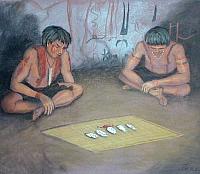
Four painted pebbles and a handful
of Mountain Laurel beans rest on a mat in front of two
men in a painted cave in a scene envisioned by artist
Reeda Peel. |
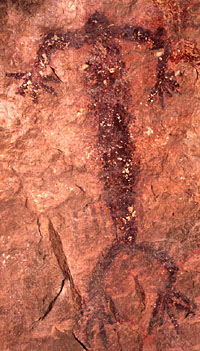
Close up of Red Monochrome pictograph.
Photo by Steve Black. |
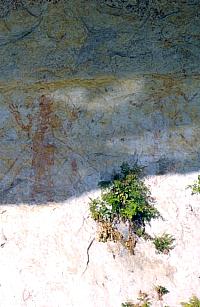
Several of the Red Monochrome figures
at Painted Rock Shelter as they appeared in 1958. Only
20 years after Kirkland, the deterioration of the images
is evident. This shelter is at the bottom of a canyon
just above a spring-fed pool of water. As you can also
see, direct sunlight adds to the problem. Photo from ANRA-NPS Archives at TARL. |

The dark band obscuring some of the
Red Monochrome pictographs at Painted Rock Shelter is
the high-water mark left by repeated, though infrequent
floods. Photo by Steve Black. |
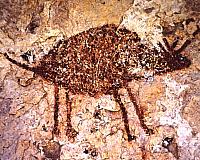
Close up of an animal figure, perhaps
representing a deer. Photo from ANRA-NPS Archives at TARL. |
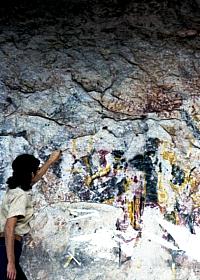
Art history researcher Penny Lindsey traces Pecos River
style pictographs onto a clear sheet of acetate in 1963.
Direct tracing is thought by some to be the most accurate,
albeit cumbersome, method of copying pictographs. Photo from ANRA-NPS Archives at TARL. |
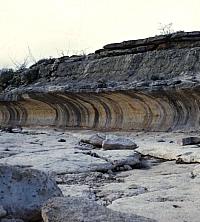
Vaquero Alcove is known for its Historic
style pictographs depicting a Christian church and a
man dressed in European-style clothing. These were painted
on the curving canyon wall protected only by shallow
overhang. Being near the canyon bottom, the rock art
panel is periodically covered by flash floods. Photo
from ANRA-NPS Archives at TARL. |
|